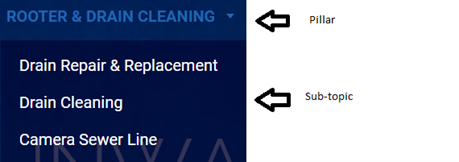Though any new website has multiple considerations, from a user-friendly design and organized architecture to an optimal buying experience, or a well-defined educational process, conducting keyword research and creating a content framework lays the foundation for success. There are multiple considerations when choosing the right content for your audience. Will the content serve your customer the information they need when they have questions? Are they receiving the correct information and CTAs for their current stage in their buying journey? Furthermore, the development of this content should not only be optimized for the customer journey, but for organic search as well. Search engine optimization should be viewed as an extension of reaching your audience when they need it most, and as an extremely valuable marketing tool.
Conducting Keyword Research for a Website
The first step in any website content strategy is conducting keyword research. Approaching keyword research differs per your website development scenario.
- Creating a new site
Use an SEO tool (SEMRush, Ahrefs, Moz, Conductor or similar) to explore keywords in your industry. Conduct a thorough competitor analysis to see what keywords competitors are targeting and who ranks in positions 1-3 in search engine result pages (SERPs) for these keywords. Take note of what content your competitor has presented on their pages that rank well for these terms. Do they have a list? Do they thoroughly answer questions surrounding their targeted keywords?
Explore gaps your competitors may not see – are there less competitive alternatives to their targeted keywords that have a similar search volume to the keywords your competitors are trying to rank for? Exploring PPC campaigns is also possible in your tool and can give a clear picture of what companies care about regarding keywords.
- Redoing or migrating an existing site
Use an SEO tool (SEMRush, Ahrefs, Conductor or similar) to view organic traffic and rankings per URL of your site.
Note:
- What pages drive the most traffic to your site, and what keywords they rank for. Maintain this content on your redone site to ensure traffic continues.
- What pages drive mediocre traffic to your site (more than 50 visits/month)? How can the content on these pages be strengthened? Are they ranking on page one for keywords with significant search volume? If the answer is no, considering how to build out this content more should be part of your strategy.
- What pages are driving no traffic? If these pages have been ineffective for long periods of time, you will want to assess whether this content is valuable to the customer and if you should include it on the new site. Alternatively, do these pages contain content that can be covered elsewhere on a different page?
- Explore new opportunities and gaps in your content by doing a competitor analysis. Are there key topics you have overlooked?
Tips for Choosing Keywords
Though search volume is important, ALWAYS consider relevance and competition for potential keywords you would like to target.
- Relevance – It is not valuable from a ranking perspective when it is too much of a stretch to relate your product/organization to a potential keyword.
- Search Volume – Looking at search volume is the most well-known way people choose keywords to target, and in search tools such as SEMRush, search volume is viewed as an approximate monthly number. A greater search volume means a greater potential return – if 10,000 people are searching for a keyword and 1,000 are searching for a related keyword, you would likely pick the word with 10k monthly search volume. However, what if it is a highly competitive search term? Or not as relevant to your offering as the lower search volume term? If your 1,000 monthly search volume keyword is highly relevant to your content, with low competition, you may have a higher likelihood of ranking in positions 1-3 in your SERPs, and even bringing in more organic traffic than you would with the higher search volume. Weighing Relevance, Search Volume and Competition is imperative in making an educated decision on which keywords to target.
- Competition — Are large sites like Amazon, Wikipedia, Government sites etc., rank on the first page of the SERPs for your selected keywords? Being realistic about ranking is essential to weigh the best keywords to target.
Content Pillars
Identifying your content pillars helps determine the overall content goals of your website and can also drive architecture and UX design.
Once you have compiled a list of relevant keywords (including those you currently have traffic for that you would like to maintain), you can identify the content pillars that will create the foundation of the content framework for your new website.
Content pillars should be deeply woven into your brand purpose and mission, aligning with overall themes and goals for your audiences. Pillars should also be easily broken down into sub-topics and additional pieces of information whether in the form of blogs, videos, pages, and other resources.
When identifying content pillars for your website, stick to less than 10 topics (10 being a relatively high amount). These topics will be broad, with more specific topics branching up to them. With website architecture, this is envisioned as a subfolder with additional URLs below it. Gather keywords related to both the pillar and the sub-topics.

Content and Keyword Mapping
Content mapping is exactly like it sounds – once content pillars and target keywords are established, where it lives on the site needs to be determined. At this stage in your content strategy journey, collaboration with UX/Design is necessary. Sharing the determined content pillars (and content needs that fall below each pillar) will help create the overall site architecture. Folders and sub-folders with planned pages should tackle each of your content goals.
Once a site architecture is determined, the content map should mirror the architecture, providing a blueprint for each URL on the site, what main keyword you are trying to rank for, and two to three supporting keywords. A simple spreadsheet can be used as your content map.
Keyword Cannibalization
Make sure your pages have distinct main keywords. If not, you may be in danger of cannibalizing. Cannibalization means many pages on the site are trying to rank for the same main keyword. According to Search Engine Journal, “Targeting a specific term across multiple pages can… do more harm than good to your SEO for that keyword. When you have multiple pages ranking for the same keyword, you force your pages to compete with each other.”
Clear content mapping ensures a lack of cannibalization, so that your ranking efforts are spread strategically, giving your keywords the best opportunity to rank possible – without competing against yourself.
Long-Term Content Strategy
Content is not stagnant. Both refreshed and new content is necessary over time. A study by Botify showed that significant content changes made to existing content prompted more frequent crawling from Google AND more ranking keywords. Planning means identifying areas to add new content or revisit old content to update. It always helps to map out these content ideas and have them at hand before launching a new or improved website.
Whether refreshing old content or creating new content, one thing Google has made clear is that it values content that is useful and relevant to users. Gone are the days of flagrant keyword stuffing. Well- thought-out, strategic content that thoroughly covers a topic is here to stay. With a proper framework for your content (and keywords), your website will be optimized and ready for both Google crawling and users.
